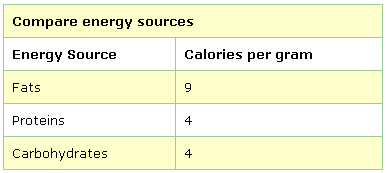|
FN 225: Nutrition
Tamberly Powell, M.S., R.D. Health Professions Division Lane Community College Eugene, Oregon
LECTURE 1A
During Week 1, start to keep track of what you eat for 3 days. You will be entering these food records into a diet analysis program and be submitting reports Week 2. There are instructions under Week 1 of moodle on how to get started with your food records. You will not submit these food records this week, but I will ask you in the study questions if you have started your food records. Keep in mind you will not be graded on what you eat.
You will only be receiving points for submitting the right reports. This
assignment is for you to
compare your nutrient and food intake to the dietary recommendations we
will be discussing throughout the term. Please be as honest and detailed
as possible when keeping your food records. This will give you the most
accurate information for completing this project. FORUM QUESTIONS: 1. Briefly introduce yourself by telling us why you are taking this course and what you hope to learn. Also, what is your favorite food? Note: FN 225 is a course designed for students entering health profession fields like Nursing and Dental Hygiene. The bulk of this course is spent discussing the six classes of nutrients. We will discuss their chemical structure, where they are found in foods, digestion, absorption, metabolism, utilization, deficiencies and toxicities. These discussions infuse chemistry, biology, anatomy, and physiology. This is an intense 4 credit course infused with lots of science. If your interest in this course is purely for personal information, and are looking for basic healthy eating and practical application, this course may go into more depth than you are wanting. We also offer a Personal Nutrition course, FN 110 which is more practical application, and less science. Please consider the above information to determine if you are in the right course! This course does not require any prerequisites, and you do not have to be a health profession major to take it. Anyone can be successful as long as you put in the time required. You will leave the course with a wealth of information that you can apply to your own life, but it will take some hard work. 2. One of the course objectives for this course is to "Acknowledge the importance of a moderate approach when it comes to Nutrition and weight management, recognizing all foods can fit into a healthful diet". Read the nutrition debate, "Are There Such Things as Good Foods and Bad Foods?" in Chapter 1 of your text (this is also posted as a pdf in moodle). Also read the article, "Why Eating Fewer Calories Won't Help You Lose Weight." What argument do these resources make for the importance of a moderate approach? Has your experience with having good, bad or forbidden foods had a positive or negative impact on your eating and your relationship to food? How do you think a moderate approach could positively impact a healthy lifestyle? 3. Read the article, "Fixed vs. Growth: The Two Basic Mindsets That Shape Our Lives." What did you learn that was new or interesting? How does this article challenge you to think differently about learning or enforce what you already believe? NOTE: If you do not want e-mail copies of the forums sent to your personal e-mail account you have to unsubscribe from the forum. You can do this by clicking on, "Unscubscribe from forum" in the settings icon to the right hand side of the screen when you are in the forums. Make sure you've printed the lecture outline for chapter 1 from moodle before viewing this lecture. You will want to fill in the lecture outline while viewing the lectures for this week. You will use the lecture outlines to help answer study questions and to help prepare for exams. I suggest putting the lecture outlines in a 3-ring binder to create a "packet" or "workbook". You SHOULD NOT print this online lecture! Once you have viewed this lecture and filled in your
lecture notes, be sure to check the box to the right of Lecture 1A under
week 1 of moodle, so you can track your completion of this assignment.
LECTURE
1A:
Chapter1- Nutrition: Linking food, function, and health Begin by looking at how this LECTURE
OUTLINE is organized. I'm hoping that these lectures help you understand the
material, not only to help you be successful on tests, but also to
deepen your understanding so you'll remember it even after the
course is over.LECTURE 1B will continue with Chapter 1. IV. Identifying Valid Nutrition Info in the News: Scientific Research V. Identifying Nutrition Info that is unreliable (not valid) & that should make you suspicious VI. 4 Guidelines for Evaluating Nutrition Info on the Web (from the LCC library)
A. Definition of nutrition- your text defines nutrition as the science that studies food and how food nourishes our body and influences our health. In this course we will be discussing how we digest, absorb, and use the nutrients in foods. We will also discuss adequate nutrient intake, deficiencies, and toxicities and how these levels impact body systems and health outcomes. We will focus on how nutrition can support health and prevent chronic diseases. B. How nutrition supports wellness Heart disease, stroke, and diabetes, which are among the top ten reasons of death in the United States (see graph below) are strongly associated with poor nutrition. Cancer is the second leading cause of death in the U.S. Around one-third of cancer deaths are linked to poor diet, physical inactivity, and carrying too much weight. (Source: American Cancer Society. Found at: http://www.cancer.org/cancer/cancercauses/dietandphysicalactivity/diet-and-physical-activity)
Source: https://www.cdc.gov/nchs/data/databriefs/db328-h.pdf According to the World Health Organization (WHO) wellness is not simply the absence of disease. Health is a state of complete physical, mental and social well-being. Achieving wellness is a journey, something we have to strive for everyday. Below is a video that demonstrates the importance of social health. It is Little Changes from Patrick Mustain on Vimeo. It comes from his blog, "What if we all just stopped trying to lose weight?"
Here is a link to the above video: https://vimeo.com/62954951 Throughout this course I will be challenging you to think of ways you can improve your wellness either physically, mentally, or socially. II What Are Nutrients? A.
Definition of a "Nutrient"-
a chemical substance in food that
is required by the body to
provide energy, give the body structure and/or help it function. USING THE ABOVE DEFINITION, which of
the following is a nutrient-
carrots, vitamin A or both __________
Click here if you think the answer is carrots. Click here if you think the answer is vitamin A. Click here if you think the answer is both. The 6 categories (types) of nutrients for humans: 1.
carbohydrates (sugar, starch, fiber)
2. lipids (triglycerides, sterols, phospholipids) 3. proteins 4. water 5. vitamins 6. minerals Which of these categories do you think should be first? Click here if your answer would be water.
Click here if your answer would be protein. Click here if your answer would be one of the other categories.
Is a potato
a carbohydrate? _________Why or why not? Click here if you think
the answer is No.
Why is it NOT appropriate to call a potato a carbohydrate? You should now be able to answer this. If you can't post a question in the student forums.
III. How Are Nutrients Classified? A. Macronutrients and Energy-Yielding Nutrients: 1.
carbohydrates (sugar, starch, fiber)
2. lipids (triglycerides, sterols, phospholipids) 3. protein Macronutrients are nutrients that the body requires in large amounts. Of these macronutrients starch, sugar and triglycerides or fats are the main fuel sources for the body and can be broken apart to yield energy for the human body. Protein also can be broken down to yield energy, but it is not a primary fuel source for the human body.
Definition of a Calorie (kcal)- kilocalories
are used to measure the energy in foods. A kilocalorie is the
amount of heat required to raise the temperature of 1 kilogram of water
by 1 degree Celsius. Often times the term Calories and kilocalories
are used interchangeably, but technically 1 kilocalorie is equal to
1,000 Calories. For simplicity, food labels use the term
Calories versus kilocalories. Throughout this course we will use
these terms interchangeably. The macronutrients (carbohydrates, fats, and proteins) are energy-yielding. As you can see in the table below, carbohydrates and proteins provide 4 Calories per gram, and fats provide 9 Calories per gram. A gram is about the weight of a paperclip. Fat is considered the most energy dense nutrient because it provides the most Calories per gram (more than double carbohydrates and protein).
When you look at the Nutrition Facts, it will list Calories, and it will also list Total Fat, Total Carbohydrates, and Protein in grams.
You can convert grams into Calories (or kilocalories) by doing the following calculations: 12 grams of fat x 9 kcal/g = 108 kcals 25 grams of carbohydrate x 4 kcal/g = 100 kcals 3 grams of protein x 4 kcal/g = 12 kcals You can double check your math by adding Calories from fat, carbohydrates, and protein, and it should come close to the total Calories listed on the Nutrition Facts. It will not always match up exactly due to rounding, and also depending on the fiber content. You should now be able to answer the question in your lecture outline, "If a hot dog has 20 grams of fat, how many Calories are coming from fat in the hot dog?" If you are not sure how to answer this, post a question in the forum.
Micronutrients are
nutrients that the body requires in smaller amounts.
1.
Vitamins.
Vitamins A, E, D, K and C are examples of vitamins. Also, there are 8 B-complex vitamins and they are thiamin, riboflavin, niacin, pantothenic acid, biotin, folate, B12 and B6. 2. Minerals. Examples of minerals include calcium, potassium, sodium and iron. Neither vitamins nor minerals can be broken apart to yield energy for the human body, although vitamins DO have energy. More about this later.
|
|
C.
Organic Nutrients Okay, so here is where we
start getting into some of the chemistry, discussing terms like
elements, bonds, organic, and inorganic. Keep in mind we will be
discussing some of these terms in more detail in week 3. I have
also posted a video on basic chemistry topics at the bottom of week 1 in moodle.
A colleague, the chemistry instructor Gary Mort, said that pictures
like the above are taken with plane polarized
light. The crystals
act as diffraction gratings and since they are at different angles, the
crystals show up as different colors. Many organic molecules can do
this.If you have taken chemistry recently you might recall the definition of an organic substance as something that contains carbon. Below I expand on that definition, because there are exceptions to this rule. Not all substances that contain carbon are organic. So I will expand the definition to state, a
nutrient (or substance) containing
carbon to carbon and carbon to hydrogen bonds which can be broken apart (also called burned)
to
release energy.
Here
is the Periodic Table of all the elements:
On the Periodic Table below, find the following elements:
carbon [C] hydrogen [H] oxygen [O] iron [Fe]. 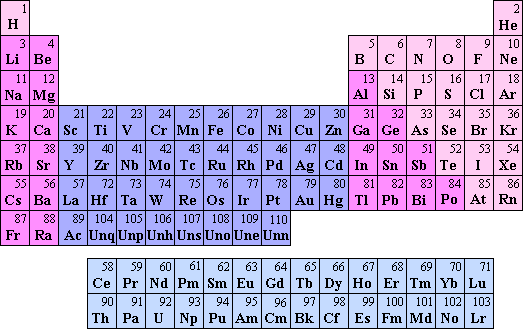
Glucose (shown below) is an organic substance because it has carbon atoms bonded to other carbon atoms
and carbon atoms bonded to hydrogen atoms which can be broken apart to release energy.  A MOLECULE OF GLUCOSE Is C02 an organic substance? Use the definition above (definition of an organic nutrient) to answer this. [C02
(carbon dioxide) is a combination of one atom of carbon bonded to 2
atoms of oxygen.]
Click here if you think C02 is an organic substance. Click here if you think C02 is NOT an organic substance. Why or why not? You should be able to answer this now. Post a question in the forums if you're still confused. Four of the 6 categories of nutrients are organic (the ones in green font). 1.
carbohydrates
(sugar, starch, fiber)
2. fats 3. proteins 4. water 5. vitamins 6. minerals The vitamins in our food ARE organic and contain energy. Why can't our bodies release this energy that is in vitamins? One reason we can NOT release the energy in vitamins is that we don't want to! Releasing the energy in vitamins would require breaking the vitamins apart. Then we would not have vitamins available for what we need them to do, such as help us heal (vitamin C) or see (vitamin A). So we don't make the enzymes needed to break apart vitamins for energy. 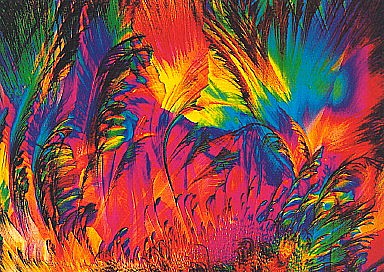 Photomicrograph of Vitamin C by Michael W. Davidson, 1990 Center for Materials Research & Technology and Institute of Molecular Biophysics The Florida State University, Tallahassee |
|
D. Inorganic Nutrients A nutrient without a carbon to carbon or carbon to hydrogen bond and it cannot be broken apart to release energy. Inorganic nutrients are not created, nor are they destroyed. Which of the 6 categories of
nutrients are inorganic? Water and minerals. These are
inorganic nutrients that plants get from the soil to grow and thrive
(they can't synthesize them since they are inorganic). The other
nutrients (carbohydrates, proteins, fats, and vitamins) plants can
synthesize since they are organic.
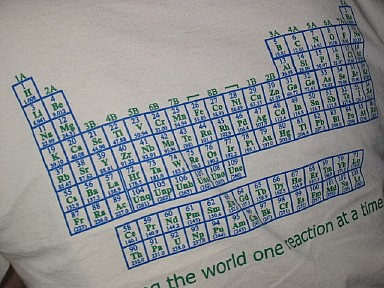 Above is another look at the Periodic Table of the Elements. 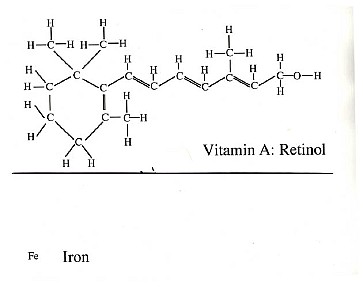 Your Turkey Cheese Frank fell into the barbecue and is now nothing but ash. Which of the six categories of nutrients is this ash composed of? The ash is composed of minerals. What did the carbohydrates, proteins, fats & vitamins become? All of these are organic and they burned up and became:
1. heat
2. carbon dioxide (which went into the air) 3. water (which evaporated) |
 This 1912 cookbook is by Fannie Merritt Farmer. Notice below how food was classified.
 Which of the 6 categories of nutrients was missing back in 1912?
|
| This is the end of Lecture 1A. Also view Lecture 1B during week 1. |
Incorrect. Carbon dioxide has just one carbon atom, so it is NOT considered organic. An organic nutrient (or an organic substance) contains carbon atoms bonded to carbon atoms which can be broken apart (also called burned) to release energy.


